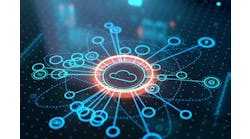Aurelio Banda has joined Motion as group vice president of automation. “Aurelio’s extensive industry background in automation distribution and manufacturing, combined with his education and training, make him a perfect fit to lead our automation strategy and accelerate growth,” says Randy Breaux, Motion president. “We look forward to watching our automation business flourish under his leadership.”
Banda most recently served as president and chief executive officer of PHD. Prior to leading PHD, he served as president and CEO—North America for Beckhoff Automation. Banda was also the owner and president and CEO of Controls Plus, an automation distributor. Additionally, he served as VP sales and regional sales manager for Motion Automation and as regional sales manager for Bosch Rexroth’s Electronic Controls & Drives.
A graduate of DeVry University with a degree in applied science in electronics, Banda furthered his education with an MBA in finance & operations from Notre Dame and completed Harvard Business School’s General Management Program.
What are three key things that a machine builder, system integrator or manufacturer should know about your organization’s automation capabilities?
Aurelio Banda, group vice president of automation, Motion: Motion offers a wide array of electrical and industrial automation products, as well as many value-added services, including engineering, fabrication, repair and IIoT/Industry 4.0 solutions across these product groups to increase customers’ productivity (Figure 1). Our proven approach is to partner closely with our customers and suppliers on applications and product developments for automation. Our principles to engineer products in designs, develop proofs of concept and deploy automation builds are keys to making a successful project with Motion.
What new technologies are driving product development and why?
Aurelio Banda, group vice president of automation, Motion: Technology advancements in machine learning, networking connectivity/protocols and ease of use in integration are the drivers leading the way in product development. As industrial automation applications expand rapidly in manufacturing, the objectives to care for improved worker safety, reduce costs, improve quality and increase flexibility underpin the technology advancements in product development deployments.
How does the Industrial Internet of Things figure into business strategy?
Aurelio Banda, group vice president of automation, Motion: IIoT has figured into business strategy with many manufacturing organizations already piloting digital initiatives with IIoT at the forefront. The functional areas with immediate implications are in supply chain management, manufacturing operations management, plant maintenance and asset management. The deployment of IIoT systems has been on the edge, at the manufacturing site and in the cloud; certainly, having strategic implications on IT and OT strategy for the organization. Scaling IIoT to capture value is rooted in offering a manufacturer ready-to-use guidance, rollout and enablement while strategically orienting their business, organization and technology for broader success.
How will machine automation and controls alter the way companies staff their operations in the future?
Aurelio Banda, group vice president of automation, Motion: As digital transformation implementations in manufacturing rise with machine automation and controls, organizations are developing roadmaps to staff their needs to address an automated factory. Companies are redeploying existing skills into new roles, while looking at what new skills are needed for external hires. Creating the right talent pool to take advantage of the automation benefits, as well as digital and analytical transformations, will be imperative for an organization to address the ongoing dynamic demand patterns in industry.
How is the development of software solutions impacting requirements for hardware?
Aurelio Banda, group vice president of automation, Motion: Software solutions move the ease-of-use needle more and more, creating a plug-and-play requirement for hardware architectures. The digital transformation in manufacturing environments will be best served to scale by reducing the complexity of an automation solution through ease-of-use software solutions with scalable hardware offering implementation. Nearly every application is complicated to a brand-new user, and manufacturers are leaning toward automation solutions with software and hardware integrated to ensure the ease of use for operators. Manufacturers can quickly realize more self-sufficient automation systems, which are scalable, cost-effective with faster ROIs, as the workforce in caring for these systems expands the operational profitability of the organization.
As engineering and IT continue their convergence, which one is and/or will be leading the direction of future automation and technology?
Aurelio Banda, group vice president of automation, Motion: A leading direction from both engineering and IT disciplines will set the pace for future automation and technology. For example, many manufacturing environments will be operating high-speed and high-volume production applications with the rise of automation and robotics acceptance in their facilities. Most advanced systems will conduct adjustments on the fly, switching seamlessly between product types without the need to stop the line to change programs or reconfigure tooling, a function of both engineering and IT disciplines. This integration convergence is seen through communication between machines/robots, the engineering discipline, on the factory floor calling on the IT discipline in oversight of the modern industrial-networking technologies.
Looking into the future, how will technology change your organization or other organizations over the next five years?
Aurelio Banda, group vice president of automation, Motion: The future of the organization is to leverage technology with the right balance on the overall operating strategy and business goals. Choosing the right level of technology implementation for future needs requires a deep understanding of the organization’s processes and manufacturing systems. For example, every project with automation considerations must be examined for the right level of technology and the improvements it can offer to directly link to the organization’s overall strategy. The outlook over the next five years shows an increase in technology accessibility due to automation platforms and networking connectivity available in the marketplace, driving the organizations to have their digital transformation road map in place to execute.
Also read: Where exactly is the network edge?





